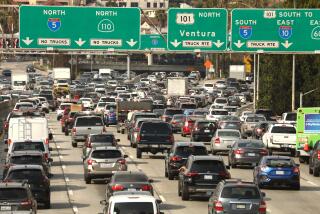Trying to Make Air Bags Safe for All
- Share via
When an infant was decapitated about a month ago in Boise, Idaho, by an air bag in what otherwise would have been a minor parking lot fender bender, a federal investigation team rushed to the scene.
Evidence has been growing that air bags, for all their benefit, can cause serious and sometimes fatal injuries to children and small adults.
After taking a slow approach to the issue, federal officials are now scrambling to put new rules into effect. These rules amount to a humbling retreat for the Washington regulatory establishment, which for years has rebuffed outside critics and prided itself on its air bag standards.
The National Highway Traffic Safety Administration last week proposed rules that would take the deadly punch out of air bags, which inflate during a collision and are supposed to cushion occupants before they hit anything inside the car.
Although the safety administration credits air bags with saving 1,700 lives to date, it now acknowledges that children and small adults face a clear danger. “Air bags have saved more than 1,700 lives, but we can and will do more to minimize their potential hazard,” said NHTSA Administrator Ricardo Martinez.
*
Indeed, the deaths of more than 30 children and 20 adults can be attributed in part to the explosive force of air bags. Particularly vulnerable are occupants of infant and child seats, as well as many small adults who are overpowered by the bags.
The larger point, apparently lost on federal safety regulators, is simply this: Safety devices shouldn’t kill, even if they save more lives than they take, said Clarence Ditlow, director of the Center for Auto Safety, the Ralph Nader-founded group in Washington, D.C. “Any child deaths [caused by an air bag] are unacceptable.”
Under the proposed rules, auto makers would be permitted on future models to reduce the deployment pressure inside an air bag by 20% to 35%, decreasing the risk to small passengers but still offering protection to everybody else.
The government would also permit dealers and independent garages to disable an air bags if a customer authorizes it in writing. Until now, disabling an air bag required federal approval.
Meanwhile, for the owners of millions of cars equipped with existing air bags, federal regulators make this warning: Children younger than 12 should ride in the rear seats of cars and infant carriers should never be placed in the front seat.
Apparently these federal regulators have never dealt with the distracting commotion that two or three children can create together in a back seat. Clearly, the recommendations are impractical for many families and impossible for larger families.
*
Critics have clamored since the early 1980s without success for sensors that would disable air bags unless a seat is occupied by a passenger of a specified minimum weight. Mercedes-Benz now uses such sensors, Ditlow said.
Air bags are not the only safety item getting a second look. A recent study by the Insurance Institute for Highway Safety, an industry group, has found that cars equipped with anti-lock brakes are more likely than cars without them to be involved in fatal accidents. Brian O’Neill, president of the group, said the government needs to quickly undertake a study to get to determine why these safety devices are failing to live up to expectations.
In the case of air bags, NHTSA plans to eventually issue new regulations for so-called smart air bags that would adjust the explosive force of an air bag to match the weight of the occupant.
Individuals wishing to comment on the proposed new air bag rules have until Feb. 5; address comments to NHTSA, Technical Reference Division, 400 7th St. S.W., Washington, DC 20590.
* Ralph Vartabedian cannot answer mail personally but will attempt to respond in this column to automotive questions of general interest. Do not telephone. Write to Your Wheels, 1875 I St. N.W. No. 1100, Washington, DC 20006 or e-mail to Ralph.Vartabedian@latimes.com.







